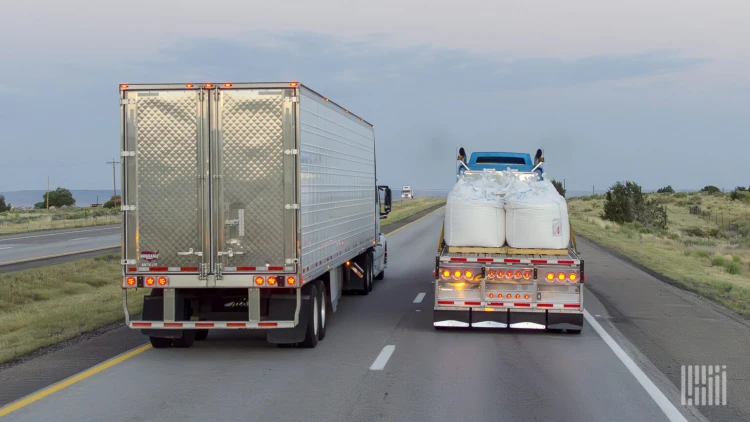Shippers Plan New Strategies, Stopgap Measures to Ease Freight Pain
Monday, 31 January 2022

Businesses rattled by high logistics costs and freight bottlenecks are extending the workarounds they adopted during the pandemic and taking on new strategies to ease their supply-chain pain in the new year.
Some are extending their use of stopgap measures, such as storing goods in idle truck trailers, while others are making deeper efforts to wring additional capacity from strained distribution networks or to trim costs by sourcing products and raw materials closer to home.
The retailers, manufacturers and distributors, including smaller businesses struggling to keep up with well-capitalized competitors, are responding to a squeeze on transportation space as companies have rushed over the past year to replenish pandemic-depleted inventories. The demand is outstripping the availability of capacity from ocean shipping to trucking and parcel-delivery networks, driving up supply-chain costs and weighing on margins.
MORE NEWS : The Next Shipping Crisis: A Maritime Labor Shortage
With the seasonal rush fading, the tactics companies undertook during 2021 remain pressing because shipping rates are expected to climb further in 2022 as robust U.S. consumer spending pushes ongoing strong freight demand and the supply-chain crunch.
“They are looking at every way they can to reduce their own costs so that they can make the equation work for them from a profitability standpoint,” said Lisa Ellram, a professor of supply chain management at the Miami University Farmer School of Business in Oxford, Ohio.
Big operators with deep resources such as Home Depot Inc. and Walmart Inc. have taken expensive steps such as chartering ships, but midsize and smaller companies have fewer resources to draw on.
HomeLife Media LLC, an Anaheim, Calif.-based business that owns iHeartCats.com and other e-commerce sites that sell pet-related products, imports most of its goods from China but started buying jewelry, dog supplements and other items from U.S. suppliers after the company’s ocean freight expenses multiplied and surging airfreight costs cut into the company’s profits.
Ivan Rodriguez, HomeLife’s vice president of information technology, said the business plans to source more goods from domestic U.S. suppliers. It has also started working with a Mexico-based metalworking company that makes pet-themed wall art and ships some orders directly to HomeLife customers. “They do daily deliveries via truck to Texas, and they have a facility that they do their fulfillment from,” Mr. Rodriguez said.
Cleveland-based logistics and fulfillment company Shipping Pilot LLC avoided some of the past year’s run-up in warehouse rents because it signed a three-year lease in May, said Greg Airel, the company’s president. But that advantage has run out as the surge in e-commerce demand has driven more goods through its single facility.
Shipping Pilot is outgrowing its 20,000-square foot space, and is now shopping for semi trailers to store overflow goods at unused truck docks. Some of the equipment Mr. Airel is eyeing isn’t in good enough shape to be used for transport so he is considering covering the trailers with tarps because parts for repairs are in short supply.
He said he expects the company to need 10,000 square feet of additional storage space next year, and the trailers will help keep him from “paying those crazy prices” for new warehouse space. Still, Mr. Airel said he’ll “have to eat that cost one day, when I run out of tractor trailers to buy or find.”
Direct-to-consumer home fitness equipment merchant Bells of Steel USA Inc. is raising prices for its customers after its cost for shipping a 40-foot container from Asia roughly quadrupled from early 2020 to the summer of this year, according to Bryan Chu, chief financial officer of the company’s Canadian owner.
“We basically try to split things between us and the consumer,” he said. “We have accepted some lower margins, but also increased our price,” selling some equipment for 10% to 12.5% more. Some items remained out of stock for long stretches, including belt squat machines stuck on a container ship idling off the Port of Los Angeles from early November to mid-December.
“Price hikes are definitely on the table, they simply have to be,” Julia Tunstall, co-founder of A Bar Above, a Carlsbad, Calif., bartending tools seller, wrote in an email. The company, whose legal name is Hillside Ventures LLC, recently paid about $29,854 for shipping a single ocean container, including an added charge for delays in handling the box. That compared with the pre-pandemic average container cost of about $4,804.
The company traditionally has assessed the prices it charges yearly, “but I think we need to do that more like quarterly nowadays,” she wrote.
Apparel and accessories wholesaler SanMar Corp. says it is facing 2022 rate increases across all modes of transport and so is focused on “making ourselves a very attractive shipper” to ensure it can move its goods as needed, said John Janson, senior director of global logistics at the Issaquah, Wash.-based company, which ships upward of 100,000 parcels a day.
For SanMar, that means getting truck drivers in and out of the company’s facilities quickly, and not tying up carriers’ equipment. The company preloads trailers for United Parcel Service Inc. to minimize wait times, he said, and aims to get drivers back on the road in 30 minutes or less.
“Price is important but capacity is even more important,” said Mr. Janson.

01 September 2024
Container Prices Double, Leasing Rates Triple in China

04 September 2024
Maersk sets new bar with shipping’s first climate target validation

06 September 2024
Port of Los Angeles Reports Another Busy Month for Cargo Volumes

09 August 2024
